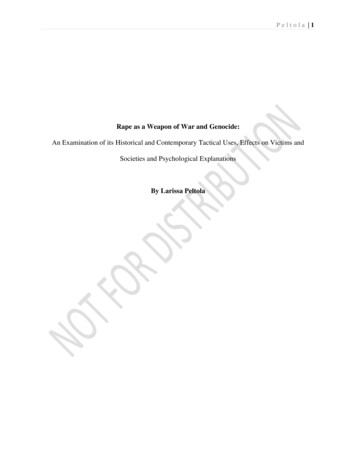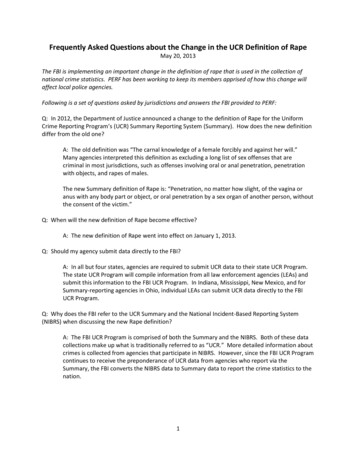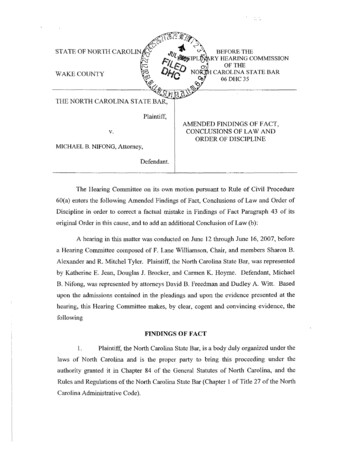
Transcription
Peltola 1Rape as a Weapon of War and Genocide:An Examination of its Historical and Contemporary Tactical Uses, Effects on Victims andSocieties and Psychological ExplanationsBy Larissa Peltola
Peltola 2IntroductionRape, and other forms of sexual violence, is a crime perpetrated against women in everycountry in the world. In the United States, 1 in 4 women are victims of sexual violence. On UScollege campuses, 1 in 5 women are likely to be victims of sexually assault. And according toAmnesty International, 1 in 3 women around the world are victims of gender-based violence. Indeveloping countries where political instability, suppression of human rights and gender bias,inequality and discrimination are commonplace, cases of sexual violence perpetrated againstwomen are exponentially higher, with figures ranging from 35–70% in some countries.The traditional definition of rape includes the lack of consent to sexual activity; however,this definition is not the standard used when discussing rape implemented as a method andweapon of war. In the document, “UN Action Against Sexual Violence,” the United Nationsasserts that “Rape committed during war is often intended to terrorize the population, break upfamilies, destroy communities, and, in some instances, change the ethnic makeup of the nextgeneration. Sometimes it is also used to deliberately infect women with HIV or render womenfrom the targeted community incapable of bearing children.”1 For centuries, rape has been usedas a spoil of war and as a weapon—possibly the most brutal weapon of war—in order to exercisepower and dominance over women and undermine the social fabric of society. It is a method oftorture2, both physical and psychological, and is a crime, just like murder, and in many casesThe United Nations, “Background Information on Sexual Violence used as a Tool of War.” The UnitedNations. Accessed on 4/26/16.1Former Special Rapporteur on Torture, Professor Kooijmans, noted that “[s]ince it was clear that rape orother forms of sexual assault against women in detention were a particularly ignominious violation of theinherent dignity and the right to physical integrity of the human being, they accordingly constituted an actof torture” U.N. Econ. & Soc. Council, Common on Human Rights, Special Rapporteur on Torture,Question of the Human Rights of All Persons Subjected to Any Form of Detention or Imprisonment, inParticular: Torture and Other Cruel, Inhuman or Degrading Treatment or Punishment2
Peltola 3women may be “raped to death.”3 The statistics are always daunting and shocking: In Rwanda,between 100,000 and 250,000 women were raped during the three months of genocide in 1994;more than 60,000 women were raped during the civil war in Sierra Leone (1991-2002); over40,000 in Liberia (1989-2003); up to 60,000 in the former Yugoslavia (1992-1995); and at least200,000 in the Democratic Republic of the Congo since 1998. Rape, sexual violence, and forcedfemale genital mutilation are outlawed under the Geneva Convention.Even after the end of wars and conflicts, rape and sexual violence perpetrated againstwomen and girls leaves a permanent mark, both physically and psychologically: unwantedpregnancies, sexually transmitted diseases including HIV/AIDS, victim shaming, stigmatizationand the ostracizing of women. Sexual violence may also persist following a conflict, often as aconsequence of impunity or due to government and societal instabilities. The United NationsHuman Rights Commission passed a resolution identifying rape as a war crime in 1993, an actthat allows for crimes of rape and sexual violence to be prosecuted as war crimes and crimesagainst humanity, and allowing for victims to seek reparations.Rape and sexual violence have been committed against women and girls for as long asman has inhabited the planet. These acts have been cited in historical documents, including thebiblical Old Testament and other religious works, depicted in sculptures and art pieces, andfound in literary tomes such as Homer’s Iliad. The notion that women are prizes—objects—to beclaimed as a reward for military conquests is one that still exists today. It is embodied in thebeliefs of male superiority and dominance over women, leading to a culture of impunity. Sogender violence is widely accepted in many countries. Oftentimes, rapists are state actors and3Carol Rittner and John K. Roth, Rape: Weapon of War and Genocide. Minnesota: Paragon House(2012). Xiii.
Peltola 4not likely to be punished. Few, if any, ever face trial. Impunity only increases the practice ofutilizing rape as a weapon.Guatemala experienced a brutal ethnic cleansing campaign against indigenous peoplesand their supporters during the 1990s that left an estimated 200,000 people dead or disappeared,150,000 displaced, and countless rapes.4 The targeting of this group and the acts committedagainst them legally constituted genocide. Similarly, the horrific ethnic cleansing campaignunleashed by the Serbians against Muslims from Bosnia-Herzegovina included the establishmentof ‘rape camps’ in which ‘non-Serb’ women and girls were taken from their homes, raped andbrutalized, often for weeks at a time. In each of these cases, impunity was a significant reason forits widespread use.5Arguably, rape is the most violent, humiliating, and brutal offense inflicted on a womanand her community, and serves as a daily reminder of the brutality of war. Rape leaves scars,physical, emotional, and psychological. In the aforementioned countries, rape was repeatedlyused as a tool of war and constituted war crimes and crimes against humanity.BackgroundWhen pressured by the international community to report crimes of sexual violence andrape, government representatives and other state actors have insisted that these ‘methods’ are notemployed strategically, but were a result of the transgression of a few ‘bad apples.’ History hasshown us that rape has been used as a tool of war, a weapon of destruction. More research isneeded on the psychology and mindset of genocidaires and their soldiers. Other research has“UN-backed commission says security forces were behind 93% of all human rights atrocities committedduring the civil war, which claimed 200,000 lives, and that senior officials had overseen 626 massacres inMaya villages.” “Guatemala profile – Timeline.” BBC online. 2016.5Victoria Sanford, Buried Secrets: Truth and Human Rights in Guatemala. New York: PalgraveMacmillan (2003).4
Peltola 5attempted to examine the psychology and mindset of why men rape. Why do armed forcesconsistently commit sexual violence against women and young girls?The answers to these questions are not always simple ones. Studies examining sexualviolence during conflicts emerged following the horrific atrocities committed in Rwanda andBosnia-Herzegovina in the early 1990s. Widespread, calculated and systematic rape wereremarkably high during these genocides with reports emerging of gang rape, sexual slavery,forced impregnation, and the establishment of ‘rape camps’ that shocked and sickened theinternational community. Rape as a tool of war has been used as a tactic during conflicts andethnic cleansing campaigns throughout history. Rapists often target their victims based on race orethnicity and many sexually violate women and girls with the specific intentions of forcedimpregnation and damaging a woman’s reproductive system. The rationale for forcedimpregnation is to breed out the ethnic lineage of children born to “undesirable” ethnic groupsand introduce the “desirable” bloodline of the rapist’s ethnic group. Damaging a woman’sreproductive system so she is unable to bear children severs the ethnic lineage. Rape often doesnot end with the act itself. Women are also beaten and physically mutilated and subjected togenital mutilation and blinding (so women would not be able to identify her attackers),amputation of limbs, and cutting off breasts, nose, ears etc.In most cases, victims of rape and sexual violence come from politically andeconomically disenfranchised populations - people often living in extreme conditions of poverty.Upset with their living situations, members of these communities often rebel against anoppressive government in the hopes of achieving political, social and economic equality. Manytheories propose that the act of rape is a way for those in power to weaken opposition groups andto maintain their control. As opposition grows, unrest sets in and those in power employ vicious
Peltola 6tactics in order to ensure their control and to protect the interests of national elites, often at theexpense of human rights and basic human dignity. In these cases, state actors respond toopposition with disproportionate levels of violence and repression, targeting those directlyopposing the state and those who are the most vulnerable: women and children. In the genocidesmentioned earlier, this was certainly the caseThe first goal of a genocidal campaign aims to “spread fear and terror indiscriminatelythroughout the civilian population.” In this case, the oppressors hope that by creating fear,opposition groups will be dissuaded from joining or providing aid to members of the opposition.The physical and psychological violence unleashed during conflicts serves to cause damage andwreak havoc on individuals and on entire communities. Sexual violence and rape are tactics thattarget the most vulnerable members of a community to achieve their goal of sending afrightening message. Rape serves as a tool to demoralize and dehumanize, and to punish‘enemies of the state.’The purpose of this paper is to illustrate several reasons why rape is an effective tool ofwar, genocide, and ethnic cleansing and examine the lasting effects it has on the victims and onsociety as a whole. I will argue that rape is a global crime, an epidemic of massive proportions. Iwill not offer suggestions on how to eliminate the use of rape as a tool of war, rather, I will showthe severity of the crime, address the psychological factors of men who rape, and prove that rapeis a weapon which demoralizes and destabilizes entire communities, removes cultural and ethnicconnections, and leaves lasting effects on societies and the global community as a whole. Rape,femicide, and sexual violence are problems the global community must address, as they can nolonger be left up to individual states and government bodies to act alone to stop them.
Peltola 7Key Themes to be explored:1) What are the historical contexts of rape during armed conflict and who are theperpetrators?2) What makes rape a widespread occurrence during war?3) Why are rape and other forms of sexual violence used as a prevalent tool of war?4) Why do men rape? Is there a psychological approach to examining rape as a tool of war?Historical Cases of Wartime Rape:Bosnia-HerzegovinaThe 1943 founding of Yugoslavia was established as a nation of six republics (Serbia,Montenegro, Slovenia, Macedonia, and Bosnia-Herzegovina) under “brotherhood and unity,” aconcept that was envisioned as a way to transcend ethno-national loyalties. Decades later withthe rise of Serbian leader Slobodan Milosevic, the Federation’s stability, prosperity and strategicimportance began to plummet. Milosevic blamed the fall of Yugoslavia on ethnic related causes,attributing all of these problems on the “ethnic other” and advocating “Serbian unity” againstethnic minorities.6 War broke out in April 1992, pitting three ethnic identities against each other-Bosnian Serbs, supported by Milosevic and his brutal regime, Bosnian Croats, backed byCroatian President Franjo Tudjman, and Bosnian Muslims known as Bosniaks. The conflictlasted for over four years during which the world witnessed unspeakable acts of violence, massrape, and horrific atrocities including the establishment of concentration and rape camps, ethniccleansing campaign, forced deportations, and genocide.767Rittner and Roth, 45-47.Ibid, 47-51.
Peltola 8The proliferation of rape as a tool of war in the former Yugoslavia shocked the world.For the first time in modern history, historians documented the calculated and methodical use ofrape and sexual violence as a weapon of ethnic cleansing and genocide. The emergence of “rapecamps” was very common in the conflict; The International Criminal Tribunal for the formerYugoslavia estimates that between 20,000 and 50,000 women and girls were raped by Serbianforces in these specifically designated camps8 9. Most of these women, according to the Tribunal,were women of Bosniak identity. The victims ranged between six to seventy years old and wereraped repeatedly and often held as captives for several years.10Many women were forcibly impregnated and held captive until termination of thepregnancy was impossible. Furthermore, many women were held as virtual slaves, forced to notonly engage in sexual acts with their rapists but also forced to cook, clean and tend to the needsof their attackers, an act meant to further humiliate and dehumanize the victim. The act ofdehumanization allowed for Serbian soldiers to see Bosniak women as property, bought and soldat their captors will, traded amongst each other, and offered as gifts or rewards to other men. Inthe case of Bosnia, rape was used with the intent to intimidate, humiliate, and degrade.11 Serbiansoldiers raped women and young girls as young as six with no regard for their humanity or theirlives, often raping them so brutally to the point of death.12 Many human rights organizationsreported that the acts of sexual violence against Muslim women and girls reached new heights ofbrutality: one report explains that “rapes of young girls [were] performed in front of their fathers,Danise Aydelott, “Mass Rape during War: Prosecuting Bosnian Rapists under International Law.”Emory University School of Law. 604.9Rittner and Roth, 47.10Ibid, 605.11Yolanda S. Wu, “Genocidal Rape in Bosnia: Redress in United States Courts under the Alien TortClaims Act.” UCLA Women’s Law Journal 4(101). 1994. 102.12Rittner and Roth, 47.8
Peltola 9mothers, and siblings; and rapes committed explicitly to impregnate Muslim women and holdthem captive until they give birth to Serbian babies.”13 14The Bosnian case had one serious problem, as do many other armed conflicts: impunityfor soldiers who rape. The war in Bosnia served as one of the most horrific examples of wartimerape; yet few soldiers faced repercussions for their crimes. Impunity served as an excuse or “getout of jail free card” for perpetrators of rape, femicide, and sexual violence. Serbian soldiersraped women and children without “regard for witnesses, and, on occasion, identify themselvesto their victims.”15 Soldiers did not fear retribution, but rather took pride in their “work.”Furthermore, Amnesty International argues that most perpetrators act with impunity, makingprosecution and legal action nearly impossible.16GuatemalaThe case of Guatemala proves a unique case in the “war-rape” rhetoric. Guatemala, asmall country in Central America, has a long history of colonialism that left a legacy ofmisogyny, cultural oppression and a distinct divide between “real Guatemaltecos” and “IndiosSucios” (“dirty Indians”). Spanish colonizers created a racial hierarchy in Central and SouthAmerica: those who had lighter skin and appeared to be more European were treated well,considered higher class, and were given political, economic and social advantages. Yet darkerskinned “Indios” were, and continue to be, treated like animals, living in rural poverty and13Ibid, 599.: See also: “Serb soldiers beat us and tore our clothes off.They pushed us on the floor. Two of the menheld me down while two others raped me. As they raped me they said they’d make sure I gave birth to aSerbian baby, and they kept repeating that during the rest of the time they kept me there.” Ibid, 599.15Wu, 102.16Amnesty International, “Bosnia-Herzegovina: Rape and Sexual Abuse by Armed Forces. 1993.14
P e l t o l a 10isolation, shunned from society and living on the outskirts of the country. In Guatemala theMayan Indians made up 42 percent of the country’s population. The Mayan peoples were, andcontinue to be, some of the most politically and economically disadvantaged in the country. In1980 for example, over 87 percent of Mayans were living in poverty.17 These factors allowedindigenous Mayan populations to become easy targets of government-sponsored genocide.The Guatemalan civil war took place between the years of 1991-1996 and wascharacterized by a series of government sponsored human rights violations against the Mayanpeople, including the use of rape against Mayan women and girls, and genocide against theindigenous population. Guatemalans lived through a series of dictatorships and authoritarianregimes following the US backed coup d’état in 1954 that installed the military regime of CarlosCastillo Armas. The worst of these dictators was Efrain Rios Montt whose military regimeduring the 1980s assumed almost absolute government power. Members of his government andmilitary successfully infiltrated every institution and sector of Guatemalan society andeliminated enemies who spoke against him. Rios Montt targeted any and all who supported“leftists” groups or ideologies. The bloody civil war that ensued during his Presidency pitted hisconservative, US backed government against various leftist rebel groups supported by peasantsand indigenous Maya. The civil war claimed the lives of over 140,000 people who had beenkilled or disappeared.18 Government forces, through official state sanctioned terror, perpetratedan overwhelming majority of these killings.Michele L. Leiby, “Wartime Sexual Violence in Guatemala and Peru.” International Studies Quarterly.53. 2000. 447.18Rashida Manjoo and Calleigh McRaith, “Gender-Based Violence and Justice in Conflict and PostConflict Areas.” Cornell International Law Journal Vol. 44, 2011. 28.17
P e l t o l a 11Of the human rights abuses that occurred, the use of rape as a way to control, suppress,and ethnically cleanse the Maya population served as a staple of the genocide. Governmentforces used rape and sexual violence as a way to spread fear and terror within Mayancommunities. This policy held two objectives: to demoralize and to spread fear. Rape served as aparticularly effective tool in demoralizing women and societies as a whole. Rape was the methodused to inflict severe physical and psychological damage to the individual and her community.Yet, rape and sexual violence took on another purpose during the Civil War: to spread fear andterror in the civilian populations. As opposition to Rios Montt’s regime increased, so did thestate’s brutality. Government forces used terror, coercion and violence in an attempt to suppressthe opposition and regain territorial control.19 The state intensified its repressive campaignagainst the Mayan populations in the hopes that their fears of being raped, tortured, or killed bygovernment agents would dissuade recruitment into leftist guerilla groups.20 Rape was used ameans to intimidate Mayan populations: soldiers sought out the mothers, daughters, sisters,wives of suspected guerillas and raped them in front of the suspected guerilla. This was anattempt to force complacency in communities and force the indigenous populations to standdown. Furthermore, sexual violence served to “weaken the opposition even when committed ona more limited and targeted scale, to punish or eliminate specific “enemies of the state.”21 By thislogic, targeted repression on civilian populations inherently undermines, or at least seeks toundermine, the ability of rebels to recruit members and retain supporters.22 Professor John Rothargues that the rape of Mayan women had several ramifications: “To rape, torture, and kill awoman especially in front of her family or community, dishonors not only the woman but also19Leiby, 449.Ibid.21Ibid, 450.22Ibid.20
P e l t o l a 12her family, community, and ethnic identity. Being raped in Hispanic Roman Catholic ortraditional Maya cultures creates profound and traumatic shame and guilt. Such violencedestroys a woman’s emotional, physical, and mental health; it irrevocably damages familial andcommunal cohesiveness.”23Rape creates physical and psychological damage for the individual and the wholecommunity.24 “The State’s militarized approach to resistance exacerbated misogyny and genderinequality in Guatemala, a nation with the most extreme gender inequalities in the WesternHemisphere, and, as stated earlier, one of the most dangerous places in the world for women andgirls.”25 The practices of state sponsored femicide and gender violence reached unprecedentedand epidemic proportions during the genocide of the Mayan people. State sponsored rape andsexual violence sought to silence female political activists such as Rigoberta Menchu, RogelioCruz and even American activists and nuns. Sister Dianna Ortiz is a US nun who worked as ateacher in Guatemala during the genocide. She was threatened with rape and murder as a tactic toscare her out of the country—a tactic that was hugely successful in intimidating and scaringwomen from joining or supporting the guerillas. Sister Dianna’s commitment to the Mayancommunities in Guatemala made her a target of state sponsored aggression, with the governmentlabeling her an enemy of the state and a guerilla subversive. “In September 1988, a local bishopwarned Sister Diana that he had received an anonymous letter accusing her of working with theguerillas. Later Sister Dianna received two death threats. “Eliminate Dianna, assassinate,decapitate, rape,” announced the first written threat. “The army knows who you are. Leave the23Rittner and Roth, 121.Leiby, 449.25Rittner and Roth, 125.24
P e l t o l a 13country,” warned the second one.”26 Since the beginning of the civil war, Maya women wereinstrumental in defending their lands, communities and cultures, making them special targets ofstate sponsored aggression and sexual violence.Democratic Republic of the CongoThe conflict in the Democratic Republic of the Congo (DRC) holds the heinousdistinction of being the deadliest conflict since World War II. Since its independence fromBelgian colonizers, the Congolese population has not benefitted from the vast natural resourcesof the country. Rather, the DRC has faced decades of extreme brutality under colonial rule,military dictatorships, and extreme poverty and destruction of resource rich lands. Today, theDRC is in the midst of a bloody conflict over its vast natural resources (primarily tin, tantalum,tungsten, and gold) involving foreign armies and several militia groups. Because of itsdevastated economy, widespread fighting for control of natural resources, rampant poverty, andcomplete breakdown of state functions, the DRC finds itself in the middle of “Africa’s firstworld war” with over 5.4 million people killed and hundreds of thousands displaced.27The DRC is suffering from another war; a war on women. The United Nations states thatmore than 200,000 women have been raped in the country since 1998, designating the DRC asthe “worst place in the world to be a woman.”28 The level of sexual violence is the worst theglobal community has seen in recent decades; physical injuries from rape are often so horrificthat many women require surgery and have lasting symptoms years after their rapes. Human26Sanford, 58.Maria Eriksson Baaz, “Why do Soldiers Rape? Masculinity, Violence, and Sexuality in the ArmedForces in the Congo (DRC).” International Studies Quarterly. Vol. 53, 2009. 500.28Human Rights Watch, “The War within the War: Sexual Violence against Women and Children inEastern Congo.” Human Rights Watch. Web.27
P e l t o l a 14rights organizations report that the rapes are so brutal that many Congolese women are “raped todeath,” contract sexually transmitted infections and diseases (such as HIV/AIDS) and areviolently raped with objects: “.in the DRC, these injuries are largely due to violent rape withobjects--gun barrels for example, or sticks and bottles--that perforate the vagina and otherorgans.”29 On CBS’s 60 Minutes program, “War against Women,” which aired on January 11,2008, Dr. Denis Mukwege, director of Panzi Hospital said: “It is a method of torture. It is a wayto terrorize the population. When I see some of the injuries on the women and children, I realizethis type of violence has little to do with sex and much more with power through a sort ofterrorism.”.30 According to Mukwege, 48 women were raped every hour in Congo during theheight of the conflict in 2006-7.31 Recent reports from local health centers in South Kivu claimthat an estimated 40 women continue to experience sexual violence every day.Human Rights Watch reported that "[Sexual violence] It's become a weapon of war ineastern Congo, used by soldiers and rebels, sometimes . the Congolese army soldiers . aregoing out on a looting and raping rampage and it's almost random those that they target. In othercases, we've seen rebels or soldiers use rape specifically to target members of a particular ethnicgroup . " “Women’s Bodies as a Battleground,” a study by the NGO International Alert,identified four types of rape carried out by militia groups on women in the Congo: “individualrape, gang rape, rape in which victims are forced to rape each other, and rape involving objectsbeing inserted into the victim's’ genitals.”32 Rape in the Congo does not have one purpose.29Rittner and Roth, 145.CBS News, “War against Women: The Use of Rape as a Weapon in Congo’s Civil War,” 60 Minutes,January 11, 2008, updated August 14, 2008.31Preethi Nallu, “Rape is being used to terrorize the population, says DRC gynecologist.” The Guardianonline. 2015.32International Alert, “Women’s Bodies as a Battleground.” International Alert online. 2005.30
P e l t o l a 15Unlike the cases of Bosnia and Guatemala, rape in the Congo encompasses a number ofexplanations: the first, rape is considered a spoil of war, men rape and commit acts of sexualviolence for their own pleasure. Second, rape is used by militia groups to terrorize communitiesinto submission. Third, rape is used as a weapon of ethnic cleansing with many soldiers hopingto sever the bloodline by so violently raping Congolese women that they become sterile andunable to reproduce.33 According to the organization Women to Women, “when a woman israped, it’s not just her that’s raped. It’s the entire community that’s destroyed. When they take awoman to rape her, they’ll line up the family, they’ll line up other members of the communitiesto actually witness that. . . . They make them watch. And so, what that means for that particularwoman when it’s all over, is that total shame, personally, to have been witnessed by so manypeople as she’s being violated.”34 Soldiers rape in order to sever the bloodline and ties of aparticular community, thereby making that community weak and vulnerable.35Often times, the effects of rape in the DRC last far longer than the act itself. For instance,the fear of rape prevented women from working the fields, thereby contributing to extremepoverty and food insecurity36. In addition, women who are not rendered infertile by their rapeoften are forced to bear their rapist’s children (as abortion is illegal in the DRC). Along with thephysical scars from rape, women often carry psychological wounds resulting in severedepression, fear, anxiety, shame, guilt, and persistent nightmares. Psychological counseling is, inmost cases, unavailable for victims of rape and sexual violence and they are forced to relive theirCarly Brown, “Rape as a weapon of war in the Democratic Republic of the Congo.” Torture. 22(1).2012. 27-28.34Solidarity, “Congo’s War, Women’s Holocaust.” Solidarity online publication. 2008.35Jonathon Zilberg, “Chapter Title: Mass Rape as a Weapon of War in the Eastern DRC.” Narrating Warand Peace in Africa Boydell and Brewer (2010).36Rittner and Roth, 148.33
P e l t o l a 16trauma every day without emotional support or guidance. Many women who are raped areabandoned by their husbands or families and labeled as “impure” “unclean” “dirty.” Women areoften re-victimized by their communities or families or by the public, often facing verbal andphysical abuse and public humiliation.37 In the DRC, no one is safe from sexual violence or rape.Victims of rape range from four months to 84 years old.38Rape as a tool of Genocide: Why it is Effective“Rape has been used historically as a form of genocide, as the destruction of a race Itproduces a sense of inadequacy on the part of the collective heart of the race, a sense ofhelplessness, a sense of worthlessness.”It is important to understand how the international community defines rape. The UnitedNations Commission on Human Rights defines war rape as “a deliberate and strategic decisionon the part of combatants to intimidate and destroy the enemy as a whole by raping andenslaving women who are identified as members of the opposition group.”39 The InternationalCriminal Court (ICC), tasked with prosecuting rape as a weapon of war, defines rape in severalelements. The first describes the perpetrators’ invasion of an individual’s body “by conductresulting in penetration, however slight, of any part of the body of the victim or of the perpetratorwith a sexual organ.” This may be done by “any object or any other part of the body.” Thesecond element states, “the invasion was committed by force, or by threat of force or coercion,”(detention, duress, violence, and psychological oppression, etc.) Finally, the ICC explains that37Rittner and Roth, 145.Pratt and Werchick, 7.39Nancy Farwell, “War Rape: New Conceptualizations and Responses.” Affilia, 19(4). 2004. 392.38
P e l t o l a 17rape is considered “as part of a widespread or systematic attack directed against a civilianpopulation,” and that the perpetrators were aware of these intended moti
war, genocide, and ethnic cleansing and examine the lasting effects it has on the victims and on society as a whole. I will argue that rape is a global crime, an epidemic of massive proportions. I will not offer suggestions on how to eliminate the use of rape as a tool of war, rather, I will show










